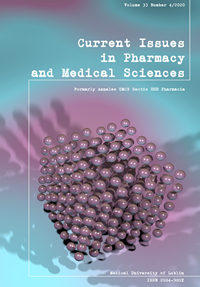Chemical constituents of Algerian mandarin (Citrus reticulata) essential oil by GC-MS and FT-IR analysis
DOI:
https://doi.org/10.2478/cipms-2020-0032Keywords:
mandarin, essential oil, Citrus reticulata, gas chromatography-mass spectrometry analysis (GCMS), Fourier-Transform Infrared Spectroscopy (FTIR)Abstract
Medicinal plants are potential sources of natural compounds with biological activities and therefore attract the attention of researchers worldwide. Citrus oils are a complex mixture of more than a hundred components of differing chemical natures. Qualitative and quantitative analysis by gas chromatography coupled with mass spectrometry (GCMS) of the Citrus reticulata essential oil collected from El Hadaïk, Skikda City (Algeria), identified 28 compounds representing a total of 99.41%. The essential oil is constituted mainly of: D-Limonene (85.10%), Sabinene (2.49%), Linalyl acetate (2.00%), Copaene (1.80%) et α-Pinene (1.75%) totaling approximately 93.14%. The essential oil was also analyzed by Fourier transform infrared spectroscopy analysis (FTIR). FTIR spectroscopy allowed us to identify 10 volatile compounds and indicated that the functional groups of the essential oils are C-H (Alkene), C-H (aromatic) and C=C. The obtained results have shown that the essential oil can be fully utilized for pharmacy, cosmetology and industry.
References
1. Moore GA. Oranges and lemons: Clues to the taxonomy of Citrus from molecular markers. Trends Genet. 2001;17:536-40.
2. Mabberley DJ. Citrus (Rutaceae): A review of recent advances in etymology, systematics and medical applications. Blumea. 2004;49: 481-98.
3. Ferhat MA, Meklati BY, Smadja J, Chemat F. An improved microwave Clevenger apparatus for distillation of essential oils from orange peel. J Chromatogr A. 2006;1112:121-6.
4. Tisserand R, Young R. Essential Oil Safety. 2nd ed. Elsevier; New York; 2014:784.
5. Mitropoulou G, Fitsiou E, Spyridopoulou K, Tiptiri-Kourpeti A, Bardouki H, Vamvakias M, et al. Citrus medica essential oil exhibits significant antimicrobial and antiproliferative activity. LWT Food Sci Technol. 2017;84:344-52.
6. Caccioni DR, Guizzardi M, Biondi DM, Renda A, Ruberto G. Relationship between volatile components of citrus fruit essential oils and antimicrobial action on Penicillium digitatum and Penicillium italicum. Int J Food Microbiol. 1998;43:73-9.
7. De Pasquale F, Siragusa M, Abbate L, Tusa N, De Pasquale C, Alonzo G. Characterization of five sour orange clones through molecular markers and leaf essential oils analysis. Sci Hortic. 2006;109:54-9.
8. Dosoky NS, Stewart CD, Setzer WN. Identification of essential oil components from Conradina canescens. Am J Essent Oil Nat Prod. 2014;2:24-8.
9. Dosoky NS, Moriarity DM, Setzer WN. Phytochemical and biological investigations of Conradina canescens. Nat Prod Commun. 2016;11:25-8.
10. da Silva JK, da Trindade R, Moreira EC, Maia JGS, Dosoky NS, Miller RS, et al. Chemical diversity, biological activity, and genetic aspects of three Ocotea species from the Amazon. IJMS. 2017;18:1081.
11. Dosoky NS, Setzer WN. Biological Activities and Safety of Citrus spp. Essential Oils. IJMS. 2018;19(7):1966.
12. Hsu CPS. Infrared spectroscopy. In: Handbook of instrumental techniques for analytical chemistry edited by Frank A. Settle. Prentice Hall: Upper Saddle River; 1997:247-283.
13. Meskine M, Ouardi O. Analyse des fréquences rovibrationnelles des molécules octaédriques. Revue Algérienne de Physique. 2010;04:62-8.
14. Robert A, Lobstein A. Plantes aromatiques: épices, aromates, condiments et huiles essentielles. Paris : Éd. Tec & doc; 2005:522.
15. Roux D. Conseil en aromathérapie. 2ème édition, pro officina (Rueil Malmaison). France; 2008:187.
16. Chiej R. Green Guide, Medicinal plants. Edition Solar; 1982:331.
17. Basil A, Jimenez-carmonna MM. Extraction of rosemary by super-heated water. J Food Chem. 1998;46:5205-9.
18. Van Den Dool H, Kratz PD. A generalization of the retention index system including linear temperature programmed gas-liquid partition chromatography. J Chromatogr A. 1963;11:463-7.
19. Davies NW. Gas chromatographic retention indices of monoterpenes on methyl silicone and Carbowax 20 M phases. J Chromatogr A. 1990;503:1-24.
20. Viuda-Martos M, Ruiz-Navajas Y, Fernández-López J, Pérez-Álvarez JA. Chemical composition of mandarin (C. reticulata L.), grapefruit (C. paradisi L.), lemon (C. limon L.) and orange (C. sinensis L.) Essential Oils. J Essen Oil Bear Pl. 2009;12(2):236-43.
21. Chutia M, Deka Bhuyan P, Pathak MG, Sarma TC, Boruah P. Antifungal activity and chemical composition of Citrus reticulata Blanco essential oil against phytopathogens from North East India. LWT Food Sci Technol. 2009;42(3):777-780.
22. Kasali AA, Lawal OA, Abanikannda OTF, Olaniyan AA, Setzer WN. Citrus Essential Oils of Nigeria Part IV: Volatile Constituents of Leaf Oils of Mandarins (Citrus reticulata Blanco) From Nigeria. Rec Nat Prod. 2010;4(3):156-62.
23. Dias RF. Spectroscopy: How do we know what organic molecules look like? Org Chem. 2005;48-58.
24. Elzey B, Norman V, Stephenson J, Pollard D, Fakayode SO. Purity analysis of adulterated essential oils by FT-IR spectroscopy and partial-least-squares regression. Spectroscopy. 2016;31(8):26-37.
Downloads
Published
Issue
Section
License
Copyright (c) 2021 Authors

This work is licensed under a Creative Commons Attribution-NonCommercial-NoDerivatives 3.0 Unported License.


